Half-Hound
Jr. Member
- Joined
- Jun 22, 2010
- Messages
- 72
- Reaction score
- 0
- Golden Thread
- 0
- Location
- Los Angeles
- Detector(s) used
- My Nose
Los Angeles, California
December, 2011
I was very happy to find what looked to me like a 1977 S IKE silver dollar coin last week. But then I read on the internet that no (40%) silver proof coins were made that year. I am confused because I thought it might be silver.
The strike quality is extremely poor - a leg is missing from the eagle on the reverse. The date and mintmark are very weak. The entire coin looks like a cheap cast from an inferior mold. It looks like something I would make, not the work of a professional counterfeiter.
I drilled about half-way through the reverse side to see the interior metal. I also saved the chips from this drilling. I then drilled a known clad IKE for comparison. There is no comparison! The chips from the possibly silver coin are very small and silver colored. The chips from the clad coin are copper colored and reached a length of about ¼ inch long before breaking up.
Is this a silver coin? I am almost certain it is not. The chips were brittle and broke is small pieces. As silver coins can be hammered into rings, I would assume real silver to be more ductile, more malleable. Are there any metallurgists out there?
Any help would be appreciated.
Thanks and Happy Holidays to everyone.
Special Hello to old-timers, Rileyboy, APUSH, MM2, Fistfulladirt and to the many others I’ve enjoyed “meeting” the last couple of years.
Just me, Half-Hound.
December, 2011
I was very happy to find what looked to me like a 1977 S IKE silver dollar coin last week. But then I read on the internet that no (40%) silver proof coins were made that year. I am confused because I thought it might be silver.
The strike quality is extremely poor - a leg is missing from the eagle on the reverse. The date and mintmark are very weak. The entire coin looks like a cheap cast from an inferior mold. It looks like something I would make, not the work of a professional counterfeiter.
I drilled about half-way through the reverse side to see the interior metal. I also saved the chips from this drilling. I then drilled a known clad IKE for comparison. There is no comparison! The chips from the possibly silver coin are very small and silver colored. The chips from the clad coin are copper colored and reached a length of about ¼ inch long before breaking up.
Is this a silver coin? I am almost certain it is not. The chips were brittle and broke is small pieces. As silver coins can be hammered into rings, I would assume real silver to be more ductile, more malleable. Are there any metallurgists out there?
Any help would be appreciated.
Thanks and Happy Holidays to everyone.
Special Hello to old-timers, Rileyboy, APUSH, MM2, Fistfulladirt and to the many others I’ve enjoyed “meeting” the last couple of years.
Just me, Half-Hound.
Attachments
Upvote
0

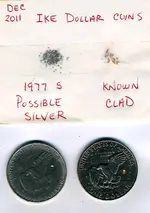
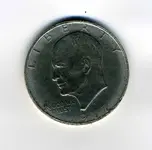
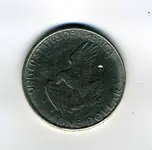
 I took a few photo,s of one of my Ike coins 1978 for comparison . I could be wrong . Jim
I took a few photo,s of one of my Ike coins 1978 for comparison . I could be wrong . Jim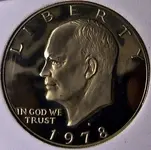
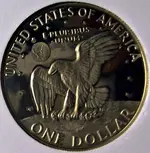
 ? I can help you......
? I can help you......